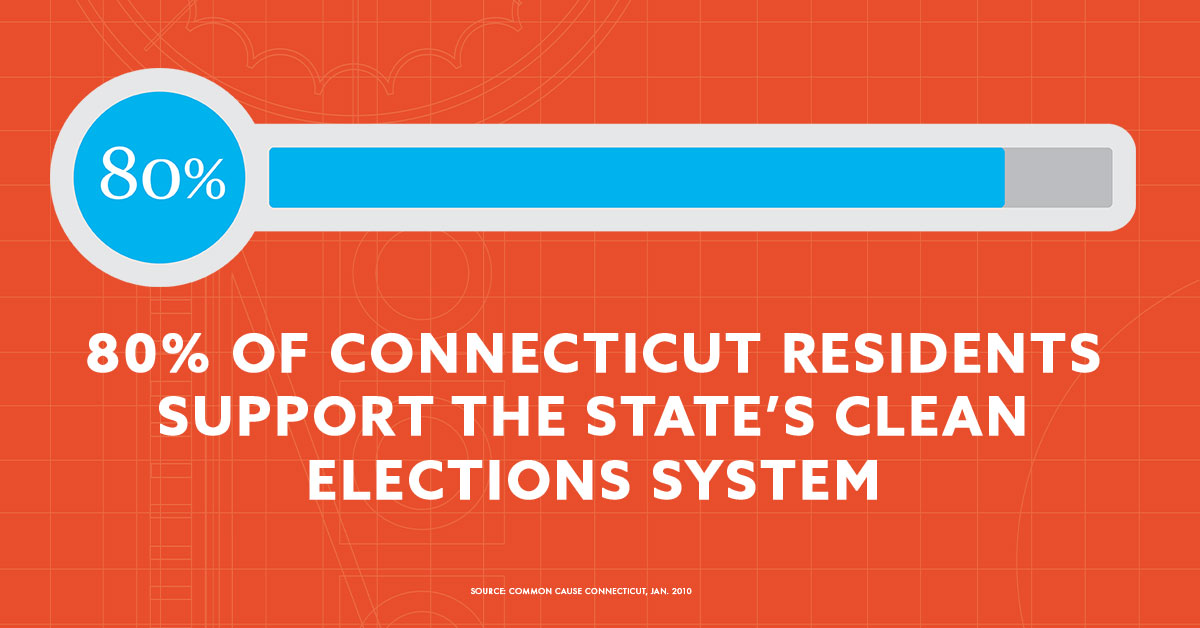Archived
Announcing Issue One’s Snapshots Project
Let’s face it: Not everyone can follow every money in politics, ethics or conflict of interest story, especially when there are daily — or hourly — developments. But we also…
Archived
This is the second installment of our blog series on Blueprints for Democracy, a new collection of solutions policymakers can implement to give everyone a greater say in their democracy. Read the full series here.
In the last Blueprints for Democracy entry, we discussed the various types of citizen funding systems. Here’s how cities and states are utilizing those different citizen funding systems to bring more people into the political process.
Connecticut – Full Public Funding
Connecticut is the poster child for citizen-funded elections for good reason. The Citizens’ Election Program (CEP) provides full public funding for qualified candidates for state office. The system frees candidates from having to kowtow to wealthy donors or interest groups, and incentivizes building a broader coalition of constituents.
To qualify, candidates must raise small-dollar donations (between $5 and $100) from Connecticut residents, so the system encourages fealty to constituents from the very beginning of the electoral process.
Candidates who opt-in earn grants of differing amounts, based on public support. In 2014, gubernatorial candidates received $6,500,400 for the general election, while state representative candidates got $27,850. And because the program is opt-in and voluntary, it can impose restrictions on spending and require extensive disclosure of activities.
The best part: the program is working. In 2012, 77 percent of winning candidates did so on public financing. Unfortunately, state Democrats have proposed suspending the program in 2016 to lower the state’s project budget deficit; Issue One and the reform community strongly condemn any attempt to weaken programs that give all citizens a greater voice in their democracy. We’ll be sure to keep you up to date as the fight to protect Connecticut’s gold standard clean elections program continues.
Learn more about Connecticut’s Clean Elections Program.
New York City – Matching System
New York City has had a citizen-funded matching system for municipal elections since 1988. All city candidates running in a contested race are eligible, so long as they agree to abide by lower contribution limits and more rigorous financial oversight. To qualify, candidates must raise a certain dollar amount in small-dollar donations (under $175) and collect contributions from a minimum number of constituents. For mayoral races, this translates to at least $250,000 in total small-dollar donations from at least 1,000 city residents.
The grant amount varies based on the level of small-dollar donations, but the matching funds are capped at a certain level. For mayoral candidates, this is $3,832,950, while city council candidates can receive up to $100,100.
The program has largely been successful in increasing both general public political participation and candidate diversity. According to a 2012 Brennan Center study, 90 percent of city census blocks had at least one small-dollar donor, and low-income and racially-diverse communities were found to be more likely to contribute to municipal campaigns than to State Assembly candidates, who do not have access to a matching funds program. This points to one reason why citizen funding programs are so important. Bringing more voters from more diverse backgrounds into the political process is critical to the long-term health and stability of an American democracy designed to represent all people.
Learn more about New York City’s Matching Funds Program.
Minnesota – Public Subsidy and Contribution Refund
In 1974, as a reaction to the Watergate scandal, Minnesota implemented a public financing program that grants a subsidy to candidates who adhere to spending limits. In addition, residents who contribute to candidates opting into the public financing system can have up to $50 of their donation reimbursed.
This contribution refund system has twofold benefits. First, it incentivizes political contributions from those who might not be financially able to donate otherwise. Second, it provides another reason for candidates to join the public financing system, because they can collect donations from a broader field of contributors who are now empowered to participate.
To qualify for the public funds, candidates must meet a number of standards, including raising a certain dollar amount of contributions, with only the first $50 from each contributor counting toward that total.
The system is very popular. Of the 312 candidates for Minnesota state office in 2014, 267, or 88.5 percent, opted into the public financing program.
Learn more about Minnesota’s Public Subsidy Program.
Connecticut, New York City and Minnesota provide just three examples of the multitude of citizen funding options available to policymakers around the country. Whatever the individual needs of a specific locality, there are a variety of programs available to build a more responsive, representative democracy that will foster a more engaged, participatory citizenry.
In the next Blueprints for Democracy post, we’ll shift to anti-corruption measures and discuss how states have been able to reduce influence peddling through ethics rules and gift bans.
Issue: Money in Politics
Archived
Let’s face it: Not everyone can follow every money in politics, ethics or conflict of interest story, especially when there are daily — or hourly — developments. But we also…
Archived
We’re excited to announce that we’ve just updated our groundbreaking Blueprints for Democracy report with the latest money-in-politics and lobbying reforms from across the U.S. During the 2016 elections voters…
Archived
Turns out that even if you’re no longer in office, you have to follow the rules and pay your bills. Which is a problem for former congressman and failed 2013…

